The
Bovine Estrous Cycle
 259-264 259-264
-
The cow is a non seasonal polyestrus species. In
other words she continually has estrous cycles all year around.
-
The
entire estrous cycle averages 21 days long, but can be as short as 18
days and as long as 24 days.
-
The stages of the
bovine cycle are
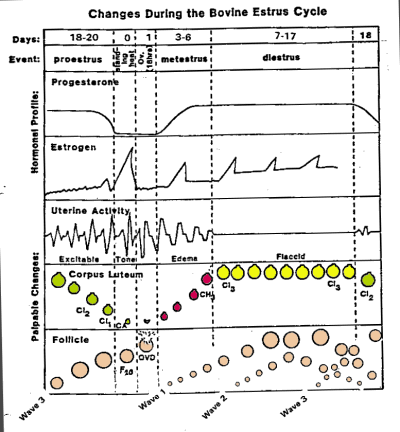
Click to enlarge

Proestrus
During the late luteal phase, if a pregnancy
recognition signal is not present by day 17-18, prostaglandin is
released. This casuses luteal regression, which means progesterone
declines. With the loss of progesterone inhibition, GnRH rises and
causes stimulation of LH and FSH. FSH causes maturation of follicles
past the antral stage. The dominant follicle establishes itself and is
the main follicle that grows. The growing follicle produces estrogen in
the granulosa cells. It is the estrogen that causes the signs of estrus
in the cow. Estrogen actually peaks before heat (estrus) and it is the
estrogen that causes the final LH release. Inhibin is also produced by
the growing follicle and prevents other smaller follicles from growing.
This inhibition of smaller follicles assures selection of a single
follicle to ovulate. The estrogen causes progesterone receptor
synthesis, which allows LH binding to luteal cells.
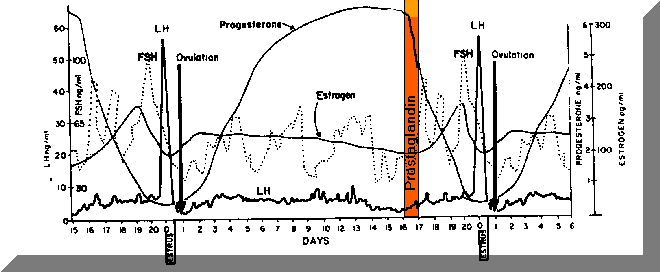
Estrus
During estrus the estrogen and FSH are declining. The
LH peaks during standing estrus. This is the time the cow is in 'standing heat', and will
stand with all four legs firmly braced to be mounted to be mounted by
another cow. Estrus lasts 18-20 hours, but may be shorter in the hot
Southeastern summer due to heat stress. The thecal cells start producing
progesterone, which inhibits LH and FSH release. Ovulation occurs 12-18
hours after the end estrus.
Metestrus
Metestrus
is 3-5 days long and is the time of luteal development. The corpus
hemorrhagicum (CH), which is the 'bloody body' that formed from the
follicle after ovulation, is developing into a corpus luteum. However,
during metestrus the corpus luteum is not yet mature, but still growing
so progesterone is rising. Since the corpus luteum is not mature, there
are no prostaglandin receptors on it, thus making luteolysis via prostaglandin impossible. The FSH surge that occurs at this time may
choose the first folliclular wave for the next cycle.
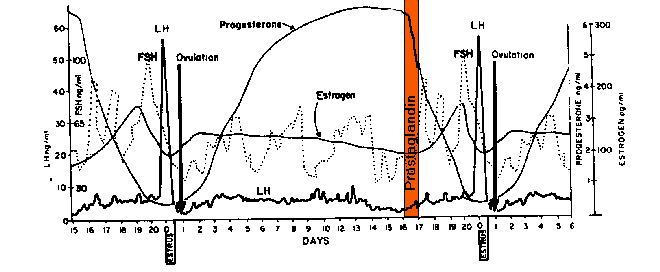
Diestrus
Diestrus lasts from days 5-17 of the estrous cycle
and is the time that the mature corpus luteum ('yellow body') is
producing progesterone. Progesterone is produced by large and small
luteal cells. The large luteal cells are derived from granulosa cells
and the small luteal cells are derived from the thecal cells. The large
luteal cells produce most of the progesterone and have the prostaglandin
receptors, while the small luteal cells have LH receptors (this makes
them capable of progesterone production, but they only produce about 20%
of the progesterone in normal circumstances). Small luteal cells can
eventually transform into large luteal cells.
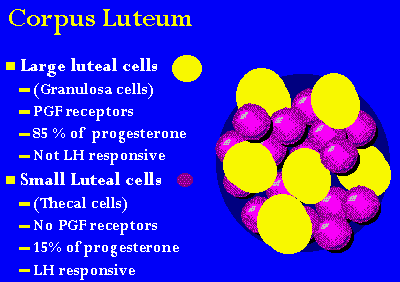
During diestrus
there are 2, 3 or 4 waves of follicular growth, depending on the
individual cow. The follicles grow, become static for about 2 days and
then become decline (become atretic ). In 2 wave cows; wave 1 starts on
day 2, wave 2 starts day 11 and it is the second wave that ovulates. In
a 3 wave cow; wave 1 starts on day 2, becomes static on days 8-12, and
declines on days 12-16; wave 2 starts day 9 and ends day 17; and then
wave 3 starts day 16 and eventually becomes the follicle that ovulates.
These follicular waves are very important in understanding a cow's
response to estrous cycle synchronization. At the end of diestrus, if no
pregnancy signal is received by the corpus luteum, the luteolytic
cascade starts.
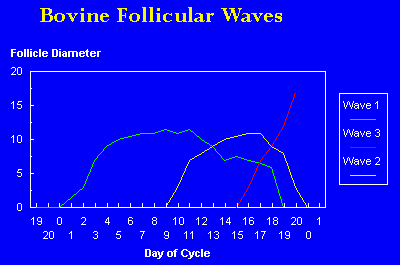

The luteolytic cascade
If
the pregnancy signal [interferon tau (IFN- tau),
or also called bovine trophoblastic protein-1 bTP-1 is not received by
the corpus luteum, then the prostaglandin that has been synthesized by
the uterus is transferred to the ipsilateral corpus luteum by a local
utero-ovarian countercurrent exchange mechanism. The prostaglandin then
binds to the large luteal cells and causes luteal death via either
direct action or a vascular constriction. The prostaglandin also causes
release of oxytocin from the large luteal cells, which causes the uterus
to release more prostaglandin. This gives a 'fail-safe' mechanism to
ensure luteal death and return to estrus for a cow that is not pregnant.
Estrogen from the dominant follicle is important in that it induces the
uterine prostaglandin synthesis and the uterine oxytocin receptors.
Truly an amazing cascade of events!
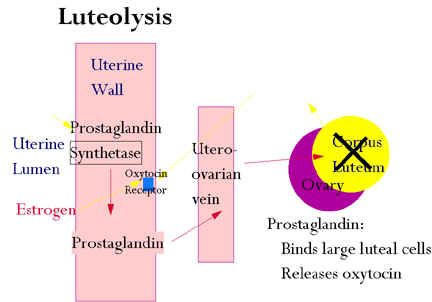 |
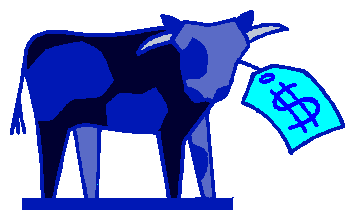 Bovine
Index
Bovine
Index
 Bovine
Index
Bovine
Index